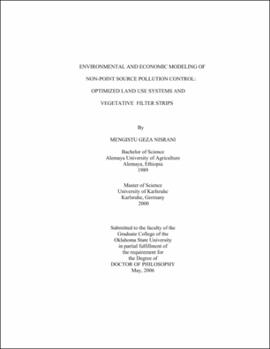| dc.contributor.advisor | Barfield, Bill J. | |
| dc.contributor.author | Geza Nisrani, Mengistu | |
| dc.date.accessioned | 2013-11-26T07:43:15Z | |
| dc.date.available | 2013-11-26T07:43:15Z | |
| dc.date.issued | 2006-05 | |
| dc.identifier.uri | https://hdl.handle.net/11244/6419 | |
| dc.description.abstract | Scope and Method of Study: The objectives of the study were to evaluate environmental and economic impacts of Non-Point Source Pollution (NPS) control approaches on a watershed scale. A Land Use Decision Model (LUDM) written using mathematical programming model (GAMS) was used to determine the optimal land use systems that maximize net returns subject to sediment and nutrient load constraints and to determine the optimal land use systems for efficient utilization of water quality incentives to minimize sediment and nutrient loads. Uniform and non-uniform sediment and nutrient load reduction approaches were also compared. Environmental and economic benefits of switchgrass production and currently used Conservation Reserve Program (CRP) were compared using LUDM model. A modified procedure for computing sediment trapping in grass filters, SGRASSF, was developed based on previously developed GRASSF vegetative filter strip model to evaluate sediment trapping efficiency on a watershed scale. Economic and environmental impact of use vegetative filter strips (VFS) was compared to total optimal replacement of parts of the watershed by grass. Soil and Water Assessment Tool (SWAT) was used to estimate sediment load in both approaches. In the optimal replacement approach, the LUDM model was used to determine the optimal land distribution. | |
| dc.description.abstract | Finding and Conclusion: LUDM built using GAMS is a useful tool to make cost effective land use decision to achieve environmental goals. The loss in income for the same amount of load reduction, as a result of replacement of peanuts by switchgrass is less than it is for replacement by CRP. The incentive required per ton of sediment or nutrient reduced as a result of replacement by CRP and minimum tillage wheat is higher than the payment required for replacement by switchgrass. The results show that whole watershed based non-uniform sediment and nutrient load reduction approach is more cost effective than Hydrologic Response Unit based uniform reduction approach. SGRASSF gives similar results to GRASSF model with an R2 value equal to 0.92. The Nash-Sutcliffe coefficient, used as an indicator of goodness of fit, was determined to be 0.9. Placement of vegetative filter strips along field drains is more cost effective compared to optimal replacement of parts of the watershed using LUDM approach. | |
| dc.format | application/pdf | |
| dc.language | en_US | |
| dc.rights | Copyright is held by the author who has granted the Oklahoma State University Library the non-exclusive right to share this material in its institutional repository. Contact Digital Library Services at lib-dls@okstate.edu or 405-744-9161 for the permission policy on the use, reproduction or distribution of this material. | |
| dc.title | Environmental and economic modeling of non-point source pollution control: Optimized land use systems and vegetative filter strips | |
| dc.contributor.committeeMember | Huhnke, Raymond Leroy | |
| dc.contributor.committeeMember | Storm, Daniel E. | |
| dc.contributor.committeeMember | Miller, Edwin L. | |
| dc.contributor.committeeMember | Stoecker, Arthur | |
| osu.filename | Nisrani_okstate_0664D_1687 | |
| osu.accesstype | Open Access | |
| dc.type.genre | Dissertation | |
| dc.type.material | Text | |
| thesis.degree.discipline | Biosystems and Agricultural Engineering | |
| thesis.degree.grantor | Oklahoma State University | |
